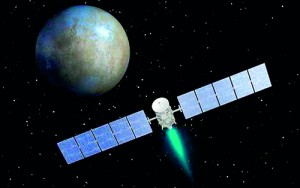Sunday Times 2
Water vapour plumes raise question about life on dwarf planet
View(s):WASHINGTON (Reuters) – The dwarf planet Ceres, one of the most intriguing objects in the solar system, is gushing water vapor from its unusual ice-covered surface, scientists said on Wednesday in a finding that raises the question of whether it might be hospitable to life.
Using the European Space Agency’s Herschel infrared space telescope, researchers spotted plumes of water vapor periodically spewing from Ceres, the largest object in the asteroid belt residing between the orbits of Mars and Jupiter.

NASA's Dawn spacecraft heads toward the dwarf planet Ceres as illustrated in this undated artist's conception released by NASA (Reuters)
The discovery comes just over a year before the scheduled arrival of NASA’s Dawn spacecraft for a closer look at Ceres, a round body measuring about 590 miles in diameter – less than a third of the size of the moon.
“This is the first time water vapor has been unequivocally detected on Ceres or any other object in the asteroid belt and provides proof that Ceres has an icy surface and an atmosphere,” Michael Küppers of the European Space Agency in Spain, who led the research published in the journal Nature, said in a statement.
The question is what is causing these plumes of water vapor from two locations on Ceres. One idea, according to scientists, is that the sun sometimes warms parts of the icy surface enough that water vapor emerges.
Another possibility, they say, is that there is liquid water under the frozen surface of Ceres and that vapor is shooting out of geysers or icy volcanoes. Dramatic geysers have been spotted on Enceladus, one of the innermost moons of the giant ringed planet Saturn.
Scientists think Ceres holds rock in its interior and is wrapped in a mantle of ice that, if melted, would amount to more fresh water than is contained on Earth.
Ceres was discovered in 1801, more than a century before the discovery in 1930 of the more famous – and more distant – dwarf planet Pluto. It is one of the few places in the solar system aside from Earth where water has been located.
A big question about the discovery of the water vapor on Ceres is what it means regarding the possibility of life.
“One of the things that’s intriguing here is the possibility of there being liquid water as opposed to ice,” Marc Rayman of NASA’s Jet Propulsion Laboratory, Dawn’s chief engineer and mission director, said in a telephone interview.
“Certainly all life that we know depends on water. And so this is part of the larger question of where can life exist.”
He said it is too early to declare that Ceres a good candidate for possible microbial life.
“I think that’s a stretch,” Rayman said. “Rather, I would say this indicates Ceres might be a good place to look to understand more about the places life could form – and perhaps places that life has formed.
“There’s a lot more than just water that’s required for life. And whether Ceres has those other ingredients – which include, for example, a source of energy and all of the nutrients that life requires, the rest of the chemistry – it’s too early to say.”
Rayman said scientists plan to use instruments aboard Dawn to map the surface of Ceres, measure its surface elevations, catalogue its minerals and study its interior structure. Dawn is due to arrive at Ceres in March or April 2015.

